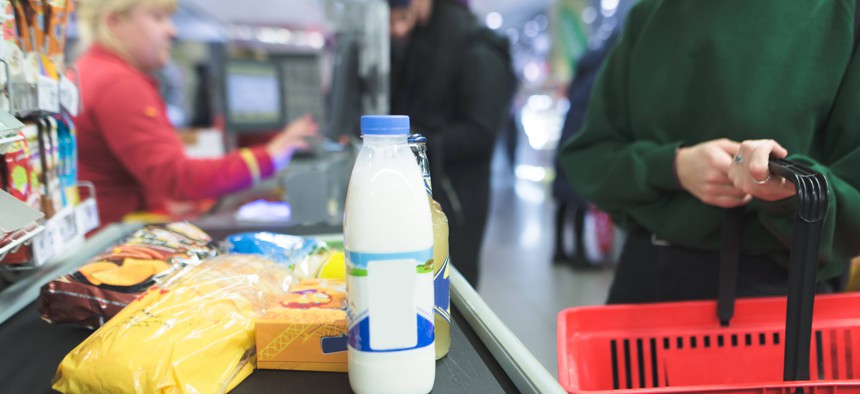Union-Backed Ballot Proposal Takes Aim at Self-Service Grocery Store Checkouts

Shutterstock
The measure in Oregon is still in the early stages.
Grocery stores in Oregon would be restricted to having no more than two automated, self-service checkout stations operating at any one time, under a proposed ballot measure that a union is in the early stages of pushing.
The Oregon AFL-CIO has submitted about 1,600 signatures to the state in an initial step toward getting the measure on the November 2020 ballot. Tom Chamberlain, the union’s president and the measure’s chief petitioner, said the proposal is in response to a rise in grocers installing automated checkout lanes.
He argues that the technology is killing jobs and unaligned with what customers want. “What we're seeing in Oregon is a rapid expansion of self-service in the grocery industry,” he said.
The Northwest Grocery Association in a statement called the proposed measure “tone deaf to what the public is demanding” and characterized it as a “union tactic to legislate grocery store management in a time of technological advancement.”
“Self-checkout is all about enhancing the customer experience in the store,” the group said.
They added that it is wrong to presume self-checkout systems will replace staff. Using the technology, the association said, allows grocers to deploy the same number of workers to manage more checkout lanes, as well as other tasks.
Bureau of Labor Statistics data show that about 3.6 million people nationwide, and about 43,600 people in Oregon, worked as cashiers as of last May. It’s one of the nation’s most common jobs.
In Oregon, the AFL-CIO represents about 20,000 grocery store workers, cashiers among them.
Future union-backed efforts like the potential ballot measure may not end with targeting only automation in grocery stores. They could extend to other industries, Chamberlain suggested.
“I think what you're seeing here in Oregon with the pushback on the self-service is just the beginning. We have to push back everywhere,” he said.
“Across this country as automation takes hold, folks are losing these jobs, we don't see an increase of the social safety net, we don't see enough support for these displaced workers,” Chamberlain added. “We're heading toward a crisis. We have to do something.”
Oregon is one of the few states, New Jersey is another, with requirements for workers to pump drivers’ gasoline at gas stations. Chamberlain described the strategy behind the grocery checkout measure as similar to the ones used to get those laws in place.
Now that supporters of the measure have submitted the initial round of signatures to the state, they’ll wait for the attorney general’s office to approve a draft ballot title for the measure.
After the ballot title process is complete, Oregon AFL-CIO plans to start collecting the 112,020 signatures that would be needed by next July to actually qualify the proposal for the ballot. Chamberlain said he expects a “multimillion dollar campaign” if the measure proceeds.
There’s been a litany of articles and reports in recent years warning of the possibility that automated technology, robots and artificial intelligence will displace human workers in sectors such as trucking, manufacturing, and food service and hospitality.
The consultant McKinsey & Company estimated in a 2017 report that automation in grocery stores “could have a significant impact on staffing needs,” with a reduction of about 65% of hours, mainly for front-end cashiers and people in stocking and cleaning jobs.
But the report added that some workers could be “repurposed toward higher value-added activities,” such as customer engagement.
There’s skepticism from some experts about the extent to which new technologies will lead to widespread job losses.
“Replacing human labor with technology is a very old story. It’s called ‘productivity growth,’” Dean Baker, an economist with the Center for Economic and Policy Research wrote recently.
He noted that if a comparable debate to the current one over automation took place a century ago it might’ve focused tractors displacing farm labor. Others have highlighted how bank teller jobs increased over three decades when ATMs became more common.
“Long and short, we do not now see any evidence of massive job loss due to robots, automation, artificial intelligence, or anything else,” Baker added. “That could change in the future, but there is little reason to believe it would lead to massive job loss.”
There are questions about where mandates to limit technology in the workplace with the aim of preserving jobs might end. Chamberlain, though, said now is a pivotal time to protect workers.
“Where do we draw the line on the livelihoods of working people in this country?” he said. “There has to be a balance between where technology is moving, at this just breathtaking pace, and the loss of jobs that has been associated with that.”
Bill Lucia is a Senior Reporter for Route Fifty and is based in Olympia, Washington.
NEXT STORY: State Legislation Setting Strict ‘Gig’ Worker Rules Nears Passage






